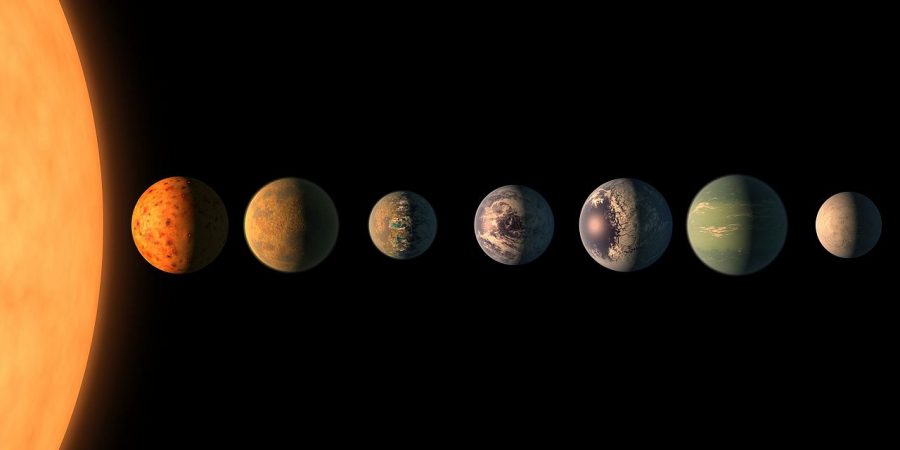NASA discovers seven new Earth-like planets
The TRAPPIST system of exoplanets marks the largest amount of planets found outside of our solar system in astronomical history.
March 29, 2017
At the forefront of space exploration, NASA recently discovered seven Earth-sized planets in orbit of a single star called TRAPPIST-1 outside of the solar system, marking the largest observed system of “exoplanets” in history. Located 40 light years away in the “habitable zone,” these planets have the possibility of supporting life due to their temperature and proximity to the red dwarf star. To continue uncovering facts about this new planetary system, telescopes on the ground, as well as space telescopes, plan to search for molecular activity and light wavelengths around them that could point to further discoveries about life outside of the solar system as a whole.
“Because of their placement in…the habitable zone within proximity to the stars, finding water and life, by extension, on these exoplanets is definitely a possibility,” physics and astronomy teacher Mrs. Ortman said. “(NASA) is using data from all different forms of satellites and telescopes to discover these planets, and the next step is using another telescope that’s out in space to detect the elements that are indicative of life such as helium, methane or nitrogen.”
TRAPPIST-1, named after the telescope used to merely study the star at the center of this planetary system a few years ago, is an ultracool dwarf, with a temperature around 5,000° F lower than our sun. Although scientists originally thought it best to search for exoplanets around sun-like stars, leading to a discovery last year of an Earth-like planet orbiting the closest star to our solar system, the bright nature of these stars made it difficult to see the extent of planets surrounding them. However, the dim light exuding around TRAPPIST made it obvious that masses would block the star at very frequent calculated times per day, leading to the utilization of high-tech space telescopes to map and discover seven new planets.
As technology such as these telescopes continue to advance, scientists progressively learn newer methods of making these groundbreaking discoveries about the universe outside of our solar system, much to the excitement of outer space enthusiasts such as senior Gabi Rodriguez.
“It’s very interesting to learn about the universe,” Rodriguez said. “I think this discovery is one step closer to finding the confirmation of other exciting new concepts in space like life on other planets, or even other systems of planets like the one that was just found.”
As NASA’s James Webb Space Telescope prepares to go into launch to study the infrared wavelengths and atmospheric makeup of the TRAPPIST-1 planets to test if life could be found upon their surfaces, many begin to make conjectures as to if they believe this life is possible.
“These planets might be life-supporting because they may have the resources we need for life such as water, oxygen, a steady temperature or other life-supporting elements that could spur the growth of microorganisms,” junior Gita Kattimani said. “I think the existence of these substances on other planets is possible, but I won’t rule out the possibility that it won’t happen; it could go either way.”
The discovery of so many exoplanets at once marks a groundbreaking period in the study of the universe, and the research methods used in the study of TRAPPIST-1 and its planets will continue to aid in future scientific findings.
“(The discovery of TRAPPIST-1) is one of the greatest discoveries in astronomical history- it’s the equivalent to us realizing that we have eight planets in our solar system or that those planets revolve around the sun,” Mrs. Ortman said. “Now, however, we’re realizing there are new planets that exist outside of our solar system, which will lead to the discovery of even more exoplanets in the future as technology progresses.”
This breakthrough is also important due to the technological advancements it will cause, creating a better future for science as a whole.
“I think this discovery is fairly groundbreaking because it opens up new possibilities for science that will only continue to grow in the future,” Kattimani said. “I think it’ll inspire new growth in technology, as well, so that space crafts can travel to examine that distance from a closer point of view than ever before- if all works out perfectly, we may even be sending humans to these planets.”
Many, such as Rodriguez, hope that this discovery and the inevitable discoveries to come will inspire people to go into scientific fields of study and be involved in testing even bigger hypotheses about the inner workings of the universe.
“It’s going to encourage more people to get into the science of the universe and space and going into NASA,” Rodriguez said. “People will be more interested and aware of what’s going on because of the huge news of this discovery, they may even be inspired by this and work to a goal of discovering more interesting questions about the universe for themselves or with their teams in NASA and space exploration.”
Mrs. Ortman also hopes this discovery will inspire young people to go into astronomy, and recognizes that massive breakthroughs such as the discovery of these exoplanets provide information to study in many areas of scientific research.
“I hope that inspires more people to go into science, especially astrophysics and the study of space sciences in general,” Mrs. Ortman said. “This impacts all fields and disciplines of scientific study, as well, because it involves geologists understanding what the planet is, chemists discovering what elements make up its atmosphere, and biologists understanding the life forms on it. So whatever field that kids go into, it’s going to impact them in some way or another.”







